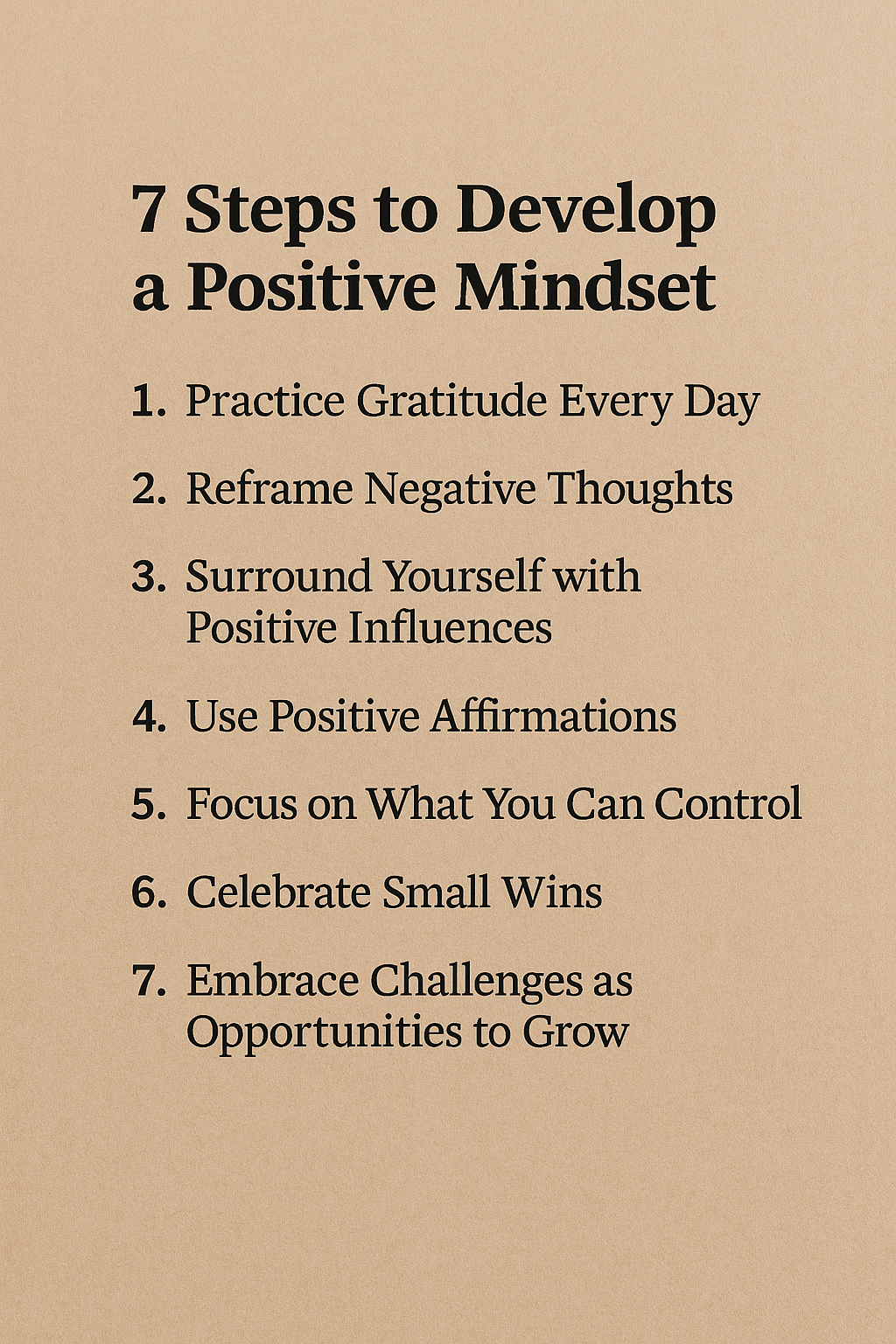Your mindset — the way you think and perceive the world — influences nearly every aspect of your life. It affects how you deal with failure, how you pursue goals, how you build relationships, and even how you talk to yourself. The good news? A positive mindset isn’t something you’re born with or without — it’s a skill you can develop through intentional practice.
In this article, you’ll learn 7 actionable steps to build and maintain a positive mindset that supports your personal growth, mental well-being, and long-term success.
What Is a Positive Mindset?
A positive mindset doesn’t mean ignoring life’s challenges or pretending everything is perfect. It means choosing to approach situations with optimism, focusing on solutions rather than problems, and believing in your ability to grow and adapt.
People with a positive mindset are not always happy, but they are resilient. They are better at managing stress, handling setbacks, and maintaining a sense of hope, even during tough times.
Let’s dive into the 7 steps to develop this kind of mindset.
1. Practice Gratitude Every Day
Gratitude is one of the most powerful tools for cultivating positivity. When you focus on what you have — rather than what you lack — your brain begins to rewire itself to notice the good in your life.
How to practice gratitude:
- Keep a daily gratitude journal
- Write down 3 things you’re thankful for each morning or night
- Be specific: instead of “I’m grateful for my family,” say “I’m grateful for the phone call I had with my sister today.”
- Express appreciation to others regularly
Over time, this simple habit shifts your perspective and boosts emotional resilience.
2. Reframe Negative Thoughts
We all experience negative thoughts. The key is learning how to reframe them — to change the story you’re telling yourself.
Example of reframing:
- Original thought: “I failed at this. I’m terrible.”
- Reframed thought: “I didn’t succeed this time, but I learned something valuable for next time.”
You can’t always control what happens to you, but you can choose how to interpret it.
Tip: Whenever you catch yourself thinking negatively, ask:
- Is this thought 100% true?
- What’s a more helpful or realistic perspective?
3. Surround Yourself With Positive Influences
Your environment has a powerful impact on your mindset. Negative, toxic, or pessimistic people can drain your energy and reinforce limiting beliefs.
Choose to spend more time with:
- Supportive friends and mentors
- Uplifting podcasts and books
- Motivational speakers or thought leaders
- Online communities focused on growth
Surround yourself with people and content that encourage you to believe in yourself and your potential.
4. Use Positive Affirmations
Affirmations are short, powerful statements that help you reshape your beliefs. When repeated consistently, they help replace self-doubt with self-confidence.
Examples of positive affirmations:
- “I am capable of overcoming challenges.”
- “I grow and improve every day.”
- “I choose progress over perfection.”
- “I have everything I need to succeed.”
Repeat affirmations daily — in front of a mirror, in your journal, or during meditation. The goal is not magic, but mindset conditioning.
5. Focus on What You Can Control
A major source of anxiety and negativity is worrying about things outside your control. Focusing on what you can control — your thoughts, actions, and responses — gives you back a sense of power.
Things you can control:
- Your effort and attitude
- How you treat others
- How you react to situations
- The goals you set
- The habits you build
Let go of what you can’t control, and put your energy into what you can influence.
6. Celebrate Small Wins
Many people wait for big milestones to feel proud of themselves. But recognizing small wins is what builds motivation and self-worth.
Start celebrating:
- Completing a task you’ve been avoiding
- Choosing a healthy meal
- Showing up even when it was hard
- Practicing kindness
- Staying consistent with a new habit
These moments matter. By acknowledging them, you train your brain to focus on progress, not just perfection.
7. Embrace Challenges as Opportunities to Grow
A positive mindset doesn’t mean you avoid hard things — it means you approach them with curiosity and courage. Instead of thinking “Why is this happening to me?” shift to “What can I learn from this?”
When you view challenges as stepping stones rather than roadblocks, your growth accelerates.
Ask yourself during difficult moments:
- What is this teaching me?
- How have I overcome challenges before?
- What strength can I develop through this?
This mindset builds resilience and long-term confidence.
Bonus Tip: Be Kind to Yourself
Your inner dialogue shapes your reality. Speak to yourself like you would to someone you care about deeply. When you mess up (and you will), show yourself compassion. Growth comes from kindness, not criticism.
Try saying:
- “I’m proud of the effort I’m making.”
- “It’s okay to rest. I’m still growing.”
- “Mistakes don’t define me — they guide me.”
Kindness fuels motivation far more effectively than shame ever will.
Final Thoughts: Positivity Is a Daily Practice
Developing a positive mindset is not about ignoring reality — it’s about choosing a healthier lens through which to view it. These seven steps aren’t quick fixes, but consistent tools that help shift your thinking over time.
Start small. Pick one or two habits to focus on this week. Practice daily. Be patient with yourself. The more you nurture a positive mindset, the more joy, peace, and possibility you’ll create in every area of your life.
